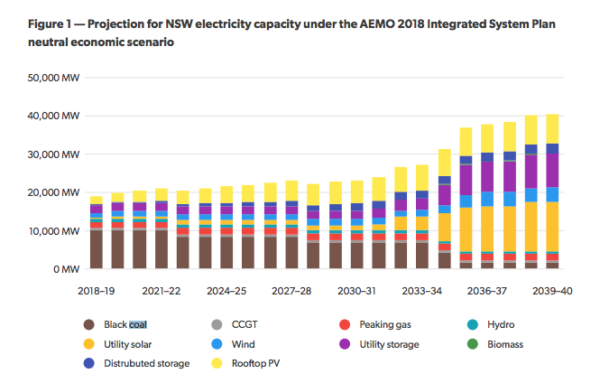The New South Wales (NSW) government has officially launched a $55 million energy program, seeking to ensure the state’s energy security and orderly energy transition.
NSW may not have a renewable energy target and is lagging behind states such as Queensland and Victoria in embracing renewables, this new program appears to be part of a plan to replace its ageing and unreliable coal power stations, such as Liddell scheduled for closure in 2022.
“Our generation mix is changing, with more variable generation entering the system and older power stations scheduled for retirement,“ reads the NSW Emerging Energy Program.
This is in line with the AEMO 2018 Integrated System Plan neutral economic scenario, which projects a significant shift for NSW from black coal to solar, both utility and rooftop, by 2040 (see the graphic below, featured in the NSW Emerging Energy Program).

“It is expected that new dispatchable, emerging energy resources will be needed in the system over the next two decades to support this transition,“ reads the program.
The program industry briefing took place on Wednesday.
“The NSW government’s emerging energy program is designed to ensure the state has large-scale, on-demand solutions for a new energy system,“ said NSW Minister for Resources, Energy and Utilities, Don Harwin, speaking to a full house.
Funding & eligibility criteria
According to the NSW government, the Emerging Energy Program, which is described as technology-neutral, is launched with a goal to leverage substantial private sector investment and support a significant number of jobs in regional NSW.
Its primary goal will be to lower barriers for investment in emerging energy projects and feasibility studies. Thereby, the program is set to enhance electricity system reliability in NSW, contribute to promoting competition in the NEM, contribute to promoting diversification of electricity supply through the development of new dispatchable, emerging technologies at utility scale and reduce greenhouse gas emissions.
The funding offered through the program will be available in the form of capital project funding of up to $10 million per eligible electricity project, and pre-investment study funding of up to $500,000.
In order for a project to win funding, it will have to meet four eligibility criteria:
- it has to be connected to the NSW region of the National Electricity Market;
- it needs to have a minimum capacity of 5 MW;
- it has to be an emerging and dispatchable technology;
- it must strive for greenhouse gas emissions reduction;
The fact that the emissions intensity maximum has a limit of 0.5 tonnes of CO2/MWh disqualifies any coal project.
In August, the NSW government announced clean energy funding to reduce power bills, allocating a total of $85 million for clean energy programs.
In addition to $55 million to help lower barriers for investment for the emerging energy projects, the funding also included $30 million for communities across the state to build their own local clean energy projects, using solar, wind and storage technology to power their homes and businesses.
The NSW Department of Planning and Environment expects to open registrations and a call for Expressions of Interest for the New Emerging Energy Program in the first quarter of 2019. The state had been under increasing pressure to introduce policies to support renewables as Victoria and Queensland took proactive steps to attract projects.
This content is protected by copyright and may not be reused. If you want to cooperate with us and would like to reuse some of our content, please contact: editors@pv-magazine.com.









2 comments
By submitting this form you agree to pv magazine using your data for the purposes of publishing your comment.
Your personal data will only be disclosed or otherwise transmitted to third parties for the purposes of spam filtering or if this is necessary for technical maintenance of the website. Any other transfer to third parties will not take place unless this is justified on the basis of applicable data protection regulations or if pv magazine is legally obliged to do so.
You may revoke this consent at any time with effect for the future, in which case your personal data will be deleted immediately. Otherwise, your data will be deleted if pv magazine has processed your request or the purpose of data storage is fulfilled.
Further information on data privacy can be found in our Data Protection Policy.